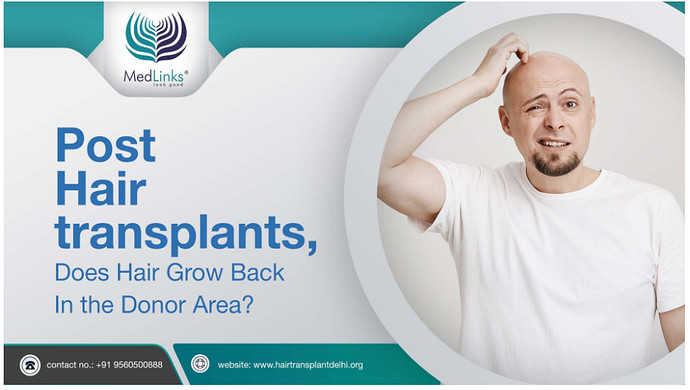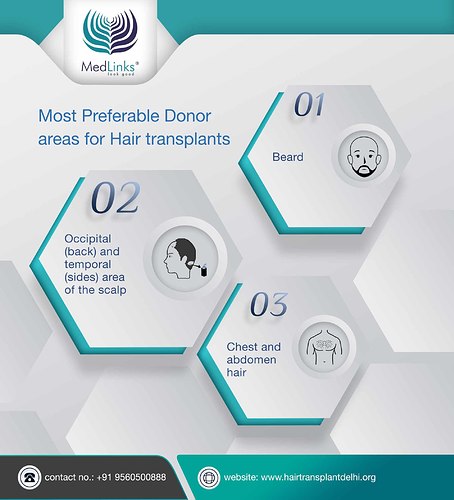Since surgeons strategically extract the grafts for the hair transplant procedure, they maintain a balance for future regrowth of the hair on the recipient site and the donor site as well.
Here, we will discuss everything you need to know about the results post hair transplant, especially with respect to the donor site.
Table of Contents
Feel free to skip ahead if one topic catches your eye
- How is the Donor Site Used During Hair Transplants?
- Is it Possible to Regrow Hair in the Donor Area?
- How to Take Care of the Donor Area After Hair Transplants?
- Cost of Hair Transplant (per graft)
- Take Away
1 How is the Donor Site Used During Hair Transplants?
The donor site of the scalp is the quintessential part during a hair transplant. The back of the scalp is often considered the donor site, especially because of the abundance of hair follicles present there.
If the patient doesn’t have a healthy growth on the back of the scalp, some surgeons suggest extracting the hair from the chest too. The reason why these are considered the most common FUE donor area is that they are genetically coded to not fall off. This leads to the abundant presence of healthy hair follicles that the surgeons can extract as grafts and then implant them into the recipient site.
Before the hair transplant procedure, the surgeons start with shaving the area of the donor site for easier extraction of the individual or unit of hair follicle grafts. Numbing gel is often applied to the donor area to alleviate the pain and make the process easier for the patient. Some patients even prefer undergoing complete sedation to prevent the risks of pain and discomfort.
During the hair transplant, the hair follicles are extracted from the donor area. The grafts with a single hair follicle are placed around the hairline of the patient while the grafts with multiple units of hair follicles are implanted around the crown of the scalp.
2. Is it Possible to Regrow Hair in the Donor Area?
Does donor area hair grow back after FUE? This is one of the most common questions that every patient undergoing a hair transplant has. As a patient, you need to understand that the hair transplant procedure is a permanent solution for hair loss. So, the removal of the hair follicles from the donor site might help with hair regrowth in the transplanted site but won’t have the same effect on the donor area.
The grafts are extracted from the donor area means that there are no more functional hair follicles left that could promote growth. It is one of the primary reasons why surgeons work with larger donor areas on the back of the scalp to make the lack of hair less noticeable.
If you are using a small donor area for a hair transplant, chances are that you will have a hard time concealing the lack of hair in the donor area. However, there are a few ways you can hide the lack of hair till the hair from the above section grows long enough to hide the donor area.
The surgeon often suggests undergoing an FUE hair transplant for individual cherry-picking of the hair follicles from the donor area. It is primarily done in the area with dense hair growth so that the missing hair follicles won’t be too visible. On the other hand, a FUT hair transplant involves taking out a strip of skin altogether through an incision, which makes the lack of hair regrowth on the donor site a lot more evident.
3 How to Take Care of the Donor Area After Hair Transplants?
Following the successful completion of the hair transplant surgery, it is necessary for the patients to take extra care of their donor area. From taking care of the stitches to pain management, there are several things that the patient needs to be cautious about:
Stitches - If you are undergoing FUT, the donor site will have sutures to stitch back the incision on the donor site. The sutures are generally removed after two weeks from the surgery. The patient doesn’t need stitches if they are undergoing an FUE hair transplant.
Medications - Taking care of the donor area after a hair transplant is extremely crucial, especially when it comes to taking antibiotics and anti-inflammatory medications. All the post-surgery medications will be prescribed by the surgeon, which needs to be strictly followed.
Avoid unhealthy habits - Habits like smoking and drinking alcohol should be prohibited completely for at least 2-3 days after the surgery. This is because alcohol and smoking tend to cause a delay in healing.
Managing pain - Hair transplant does inflict the risks of pain and swelling after the surgery. You will likely need to take pain medications for 2-3 days after the surgery to manage the pain and discomfort.
Sleeping - The surgeon will suggest sleeping on the back with a soft pillow underneath the head to support the incision and prevent putting excess pressure on the site of the surgery. Sleeping on the stomach is strictly prohibited.
Strenuous activities - To promote faster recovery of the hair transplant in the donor area, the patient needs to avoid doing physical activities for at least two weeks after the surgery. This reduces strain on the donor site and ensures faster recovery.
Numbness - The donor area feels numb because of the effect of the numbing gel for sometime after the surgery. While the feeling does get better after a few hours of the surgery, if you notice any kind of prevailing numbness or oozing, it is better you consult a doctor immediately. These initial symptoms are standard for 48 hours after the surgery. Anything more than that needs medical attention.
Protective Covering - Once you are done with the surgery, the surgeon will likely wrap the entire scalp with a bandage to ensure a faster recovery. This also prevents the risks of infections. However, for individual protection and care, you need to avoid prolonged sun exposure because that can affect the newly implanted grafts on the scalp. Unnecessary sun exposure can also result in sunburns, which further enhance the risks of infections.
Bleeding - Bleeding from the donor and recipient site after a hair transplant surgery is normal. All you have to do is apply light compression on the site to stop the bleeding. In case it doesn’t stop even after that, it is better that you consult your surgeon for further help.
Infections - Suffering from infections in the donor area is rare but doesn’t mean it won’t happen. It is necessary that you take care of the wound and also avoid leaving the wound open. Avoid touching the donor area with dirty hands too.
Grooming - It is important to avoid combing the hair on the day of the transplant. Use a wide-tooth comb to ensure that it gently combs through the hair without irritating the scalp and the implanted hair follicles.
Hair Washing - It is necessary that the patient uses gentle shampoos that aren’t formulated with a lot of chemicals. Avoid direct water flow on the donor area and the recipient site of the scalp. Wash your hair with the tip of your fingers instead of the nails. Also, avoid using products like hair spray, foam, and even hairdryer for at least 2-3 weeks after the surgery.
4. Cost of Hair Transplant (per graft)
The cost of a hair transplant in India is subjective and depends on the type of procedure the patient is undergoing along with the number of grafts the recipient site requires.
The cost of FUE hair transplant per graft generally starts from INR 20 while that of the FUT and DHT can start from INR 25 per graft. The cost of other types of the latest treatment options, including Perfect-I and Quick FUE transplant, depends on the charges levied by the clinic and the consulting surgeons.
Take Away
Hair transplant is one of the most effective modes of hair restoration. However, it brings along several factors of consideration, the donor hair regrowth is one of the most crucial ones. If you have queries concerning the same, we hope this article was informative enough for you to get all the basic answers.
For further information and a personalized treatment plan, Medlinks is here to assist you with the best treatment options along with the latest techniques (Perfect-I) at affordable costs and proper aftercare instructions.

